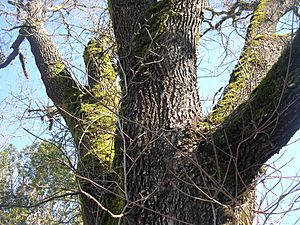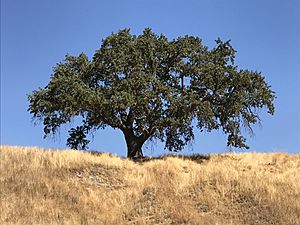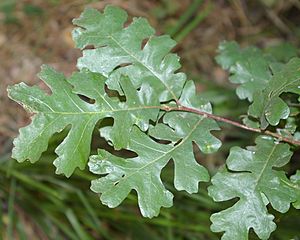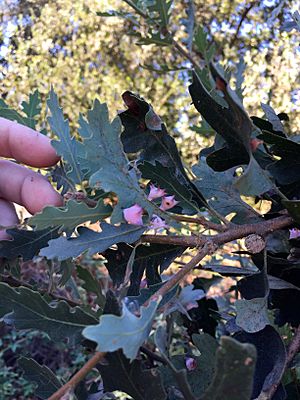Valley oak facts for kids
Quick facts for kids Valley oak |
|
|---|---|
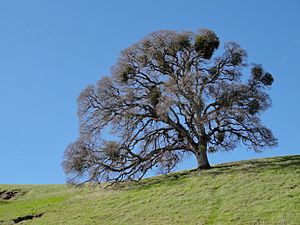 |
|
| Valley Oak near Mount Diablo, with Mistletoe. | |
| Conservation status | |
| Scientific classification | |
| Genus: |
Quercus
|
| Species: |
lobata
|
 |
|
| Natural range of Quercus lobata | |
| Synonyms | |
|
List
Quercus hindsiana Benth. ex Dippel
Quercus hindsii Benth. Quercus longiglanda Torr. & Frém. Quercus lyrata Spreng. |
|
The Quercus lobata, often called the valley oak or roble, is the biggest type of oak tree in North America. It grows only in California, from Siskiyou County in the north to San Diego County in the south.
These amazing trees can live for a very long time, sometimes up to 600 years! Valley oaks are deciduous trees, meaning they lose their leaves every year. They need a lot of water all year round from underground sources.
You can easily spot a valley oak by its thick, ridged bark, which looks a bit like alligator skin. Their leaves are also easy to recognize because they have deep, rounded lobes.
Contents
About the Valley Oak
The trunk of a valley oak can be super wide, more than three meters (10 feet) across! These trees can also grow very tall, over 30 meters (100 feet) high. The "Henley Oak" in Covelo, California, is the tallest known oak in North America, standing at 46.6 meters (153 feet).
Branches and Leaves
Valley oak branches grow in a unique, spreading way, making a cool shape against the winter sky when there are no leaves. In autumn, their leaves turn yellow or light orange. By late fall, they become brown. As the tree gets older, its branches start to droop down. The bark is a silvery-gray color and has ripples, which makes the tree look even more beautiful.
The leaves are usually five to ten centimeters (2–4 inches) long. They are about half as wide as they are long and have deep, round edges. The top of the leaf is a dull green, and the bottom is a lighter green. The leaves feel soft and fuzzy, almost like velvet. If you rub or break a fresh leaf, it gives off a nice, forest-like smell. The wood of the valley oak is a dull brown, almost yellow, and isn't used much for building.
Acorns and Animals
Most valley oak acorns fall in October. Many different mammals and birds love to eat them. These include the acorn woodpecker, California scrub jay, yellow-billed magpie, and California ground squirrel. Some tiny beetles called bruchid beetles also attack the acorns, but many still survive. Any acorns that survive will sprout in their first winter.
The acorns are medium to dark brown and are about two to three centimeters (0.8–1.2 inches) long. Their caps have a bumpy texture. You usually find acorns alone, but sometimes they grow in pairs. The Concow tribe calls these acorns lō-ē’ in their language.
Galls and Wasps
You might see round bumps, called galls, on the twigs of older valley oaks. These galls can be several centimeters wide. Inside them live the baby (larval) stages of tiny native wasps called Andricus quercuscalifornicus. Another type of wasp, A. kingi, makes smaller galls on the leaves that look like Hershey's Kisses. The valley oak is also the only plant that Chionodes petalumensis caterpillars eat.
Fire and Survival
Like many oak trees, valley oaks can handle wildfires. Even if smaller trees get burned on top, most can grow back from their roots.
Where Valley Oaks Grow
Valley oaks can handle cool, wet winters and hot, dry summers, but they need plenty of water. They grow best in rich, deep soil in valley floors, usually below 600 meters (2000 feet) in height. You can find them in thick forests near rivers, in open foothill woodlands, and in valley savannas (grasslands with scattered trees).
Neighboring Trees
Other trees that often grow near valley oaks include the coast live oak, interior live oak, blue oak, California black walnut, California sycamore, and gray pine.
Locations in California
Valley oaks are found all over the Central Valley in California. They also grow in many smaller valleys like the San Fernando Valley, Conejo Valley, and Santa Ynez Valley. You can see them in the Inner Coast Ranges and the Transverse Ranges. They even grow on Santa Cruz Island and Catalina Island in the Pacific Ocean. Some of the most beautiful groups of valley oaks are in Sonoma Valley, Round Valley in Mendocino County, and the southern Salinas Valley.
Valley Oak History
The valley oak belongs to the "white oak" family, which includes many oaks from California and other places. These oaks have similar leaves, acorns, bark, and wood.
Old Names for the Tree
Early settlers in California used many different names for the valley oak. Some called it white oak, bottom oak, swamp oak, water oak, or mush oak. The Spaniards called it "roble" because it looked like the white oaks they knew from Europe.
Historical Accounts
In 1792, an English explorer named George Vancouver traveled through the Santa Clara Valley. He saw so many valley oaks that he wrote: "For about twenty miles it could only be compared to a park which had originally been closely planted with the true old English oak." He thought it looked like a beautiful park with grand old trees.
In 1861, William Henry Brewer, a main botanist for the first California Geological Survey, wrote about the valley oaks in Monterey County. He said, "Some of these oaks were noble ones indeed." He measured one valley oak that was 26.5 feet around (8 meters) and another that was over six feet (1.8 meters) wide, with branches spreading more than 75 feet (23 meters) in every direction!
The Hooker Oak in Chico, California, was once thought to be the biggest valley oak ever. When it fell on May 1, 1977, it was almost 30 meters (100 feet) tall. Its trunk was 8.8 meters (29 feet) around, about 2.4 meters (8 feet) from the ground.
Uses of the Valley Oak
The acorns of the valley oak are sweet and can be eaten. Native Americans used to roast them. They also ground the edible part into a meal to make bread and mush.
Wood Uses
It can be tricky to get and dry valley oak wood because it tends to crack and warp. Because of this, it's not used for general lumber very often. However, it is used for special things like making cabinets and hardwood floors. The wood also has special parts called tylose that make it waterproof. This means it can be used to make barrels that hold liquids, like wine barrels.
See also
 In Spanish: Roble de los valles para niños
In Spanish: Roble de los valles para niños



